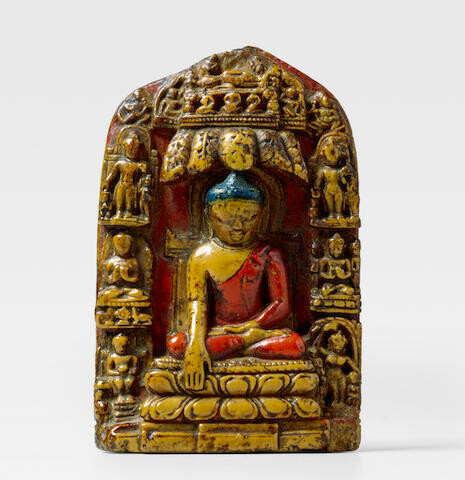A STONE PLAQUE WITH SCENES FROM THE LIFE OF BUDDHA
NORTHEASTERN INDIA, PALA PERIOD, CIRCA 12TH CENTURY
NORTHEASTERN INDIA, PALA PERIOD, CIRCA 12TH CENTURY
With later polychromy.
Himalayan Art Resources item no.61911
3 5/8 in. (9.2 cm) high
????? ???? ????? ????????
Rubbed and worn to a smooth buttery patina, this intricate plaque must have been treasured as a personal object of devotion. Portable plaques like this were produced during the Pala period in Northeastern India around the 11th and 12th centuries, probably as mementos for pilgrims to the region's famed sites. Each associated with a pilgrimage site, the sculpture depicts the eight major events in Shakyamuni Buddha's life. These are, clockwise from bottom left: the gift of honey by a monkey at Vaisali, the first sermon at Sarnath, taming of the wild elephant at Rajagrha, mahaparinirvana at Kusinagara, the descent from Trayastrimsa heaven at Sankasya, performing miracles at Sravasti, and the birth at Lumbini. Lastly, the larger central scene represents Buddha's defeat of Mara at Bodhgaya.
These plaques played a pivotal role in the spread of Buddhism, having been found in China, Burma, Sri Lanka, and Tibet. A closely related example in Tibet, showing similar physiognomy in Buddha's broad forehead and short neck, is preserved in the Potala Palace, Lhasa (von Schroeder, Buddhist Sculptures in Tibet, Hong Kong, 2001, p.400, no.129A).
Provenance
Private Asian Collection, acquired in Hong Kong, 1992
View it on
Estimate
Time, Location
Auction House
NORTHEASTERN INDIA, PALA PERIOD, CIRCA 12TH CENTURY
NORTHEASTERN INDIA, PALA PERIOD, CIRCA 12TH CENTURY
With later polychromy.
Himalayan Art Resources item no.61911
3 5/8 in. (9.2 cm) high
????? ???? ????? ????????
Rubbed and worn to a smooth buttery patina, this intricate plaque must have been treasured as a personal object of devotion. Portable plaques like this were produced during the Pala period in Northeastern India around the 11th and 12th centuries, probably as mementos for pilgrims to the region's famed sites. Each associated with a pilgrimage site, the sculpture depicts the eight major events in Shakyamuni Buddha's life. These are, clockwise from bottom left: the gift of honey by a monkey at Vaisali, the first sermon at Sarnath, taming of the wild elephant at Rajagrha, mahaparinirvana at Kusinagara, the descent from Trayastrimsa heaven at Sankasya, performing miracles at Sravasti, and the birth at Lumbini. Lastly, the larger central scene represents Buddha's defeat of Mara at Bodhgaya.
These plaques played a pivotal role in the spread of Buddhism, having been found in China, Burma, Sri Lanka, and Tibet. A closely related example in Tibet, showing similar physiognomy in Buddha's broad forehead and short neck, is preserved in the Potala Palace, Lhasa (von Schroeder, Buddhist Sculptures in Tibet, Hong Kong, 2001, p.400, no.129A).
Provenance
Private Asian Collection, acquired in Hong Kong, 1992



